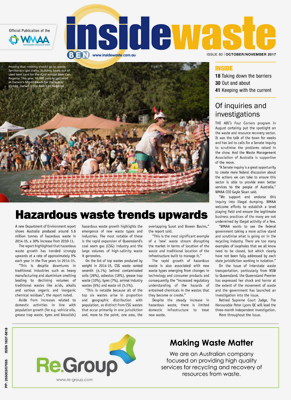The State of Energy from Waste
By Mike Ritchie, MRA Consulting Group
When developed alongside strong recycling and organics processing systems, Energy from Waste (EfW) will help lift domestic and commercial diversion rates from 60% to 80-90%. It is an important element in a waste management system.
Whilst Australia continues to have projects that either fail or don’t perform as well as was initially hoped, we are seeing more projects that are succeeding. That’s a good thing for the industry, and will build confidence in EfW.
A simple way to look at EfW is to consider it in three tiers:
- Organics processing – this takes source separated organics and generates gas, mainly by anaerobic digestion, and an organic byproduct.
- Processed Engineered Fuel – producing a fuel (PEF) for export.
- Domestic waste to energy facilities – converting waste into energy locally, typically through mass burn incineration (though gasification and pyrolysis has also been proposed).
There has been progress on each front.
Organics processing
There has been strong progress on anaerobic digestion plants for clean organics. These include:
- Earthpower at Camellia in Sydney, operated as a joint venture between Cleanaway and Veolia. A 50,000 tonne per year facility.
- Richgro at Jandakot in Perth, providing electricity and organics at an existing composting facility. A 55,000 tonne per year facility.
- Yarra Valley Water at Wollert in Melbourne, located adjacent to a wastewater treatment plant. A 33,000 tonne per year facility.
This is a space where we can expect considerable growth around Australia, just as there has been in the UK and Europe.
The Brockwaste facility at Shenton Park in Perth was in voluntary administration for some time, and has recently been purchased from the administrators by Shenton Energy. Hopefully this facility, intended to convert mixed MSW into energy through an anaerobic digestion process developed by AnaeCo, will complete commissioning and commence operations soon.
After many years of promise, it appears that biochar is going to be developed on a commercial scale. The Eastern Metropolitan Regional Council (EMRC) is developing a pyrolysis plant to convert 13,000 tonnes per year of waste timber into energy and biochar at its existing Hazelmere Resource Recovery Park in Perth. Again, this will be a strong confidence builder.
Processed Engineered Fuel
There is a substantial market for PEF, including a proposal to convert part of the Mount Piper coal fired power station in NSW to run on PEF, and significant demand for PEF exports to replace coal in cement kilns.
The production of PEF in Australia has been led by ResourceCo with a 2006 facility at Wingfield in Adelaide. That facility, now owned by SUEZ-ResourceCo, converts about 300,000 tonnes per year of waste into 150,000-200,000 tonnes of fuel for the local Adelaide-Brighton cement kiln.
On the back of the Adelaide success, ResourceCo obtained a $5m Waste Less, Recycle More grant, and $30m loan from the Clean Energy Finance Corporation to establish a 150,000 tonne per year facility at Wetherill Park in Sydney, and a further facility in another State (to be announced).
There are further proposals from Re.Group and Veolia to produce PEF at their existing Sydney facilities.
Domestic Waste to Energy
We are seeing the emergence of large scale waste to energy plants in Australia.
Current proposals that are moving through approvals include:
- Dial-A-Dump Industries The Next Generation facility, proposed for Eastern Creek in Sydney. The proponent has applied for a facility processing over 1 million tonnes per year of post-sorted C&I and C&D waste.
- Phoenix Energy, proposed for Kwinana in Perth. This facility has contracts with a number of Perth Councils, and has been trying to reach financial close for over a year. The facility is proposed to receive 400,000 tonnes per year of MSW.
- Consortium of Hitachi Zosen Inova, New Energy Corporation and Tribe Infrastructure group, proposing a facility for 300,000 tonnes per year of MSW at East Rockingham in Perth. The consortium was recently announced as the preferred tenderer for the EMRC EfW tender.

There are two main technology providers for these waste to energy plants in Australia: Hitachi Zosen Inova and Martin Biopower. Both are mass burn incinerator providers. Mitsubishi Heavy Industries has ended its 40+ year relationship with Martin GmbH for the provision of incineration technology, and so is no longer present in the Australian market.
HZI is supporting the Dial-A-Dump and East Rockingham proposals. The Phoenix Energy proposal was supported by Mitsubishi.
I think Australia will see a shift in the development of Waste to Energy, where future proposals will be led by HZI or Martin Biopower. They will partner with infrastructure funds for finance, engineering companies for construction, and waste companies for operation.
Where Australia is headed
The clear trend going forward is more development of organics processing plants. Whether anaerobic digestion or biochar, this technology will continue to be developed across the country.
I think we will also see substantial development of PEF, especially from C&I waste. It is relatively straightforward to export bales of waste from existing processing facilities, especially if that waste is currently baled.
Finally, I think we will get very close to developing our first domestic waste to energy facility. After many years of refining contract delivery models, and setting up the regulatory framework to ensure EfW doesn’t cannibalise recycling, it seems that there is enough momentum for something to happen. It remains to be seen where the first plant will be.
As always, I welcome your input on this, or any other topic on ‘The Tipping Point’.
Featured image: an architect’s perspective of what the TNG facility will look like (Source: Dial A Dump Industries)
This article has been published by the following media outlets:
 Inside Waste, October 2017 (click to view)
Inside Waste, October 2017 (click to view)



